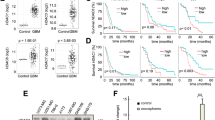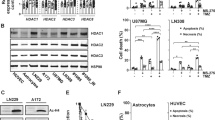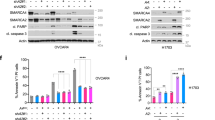Abstract
Despite aggressive therapies, the prognosis of children with high-risk medulloblastoma is still poor, thus underscoring the need to develop novel treatment strategies. Here, we report that histone deacetylase inhibitors (HDACI), that is, MS-275, valproic acid or SAHA, provide a novel strategy for sensitization of medulloblastoma to DNA-damaging drugs such as Doxorubicin, VP16 and Cisplatin by promoting p53-dependent, mitochondrial apoptosis. Mechanistic studies reveal that single-agent treatment with MS-275 causes acetylation of the non-histone protein Ku70, an event reported to release Bax from Ku70, whereas DNA-damaging drugs trigger p53 acetylation and accumulation. Combined treatment with MS-275 and Doxorubicin or VP16 cooperates to promote binding of p53 to Bax and p53-dependent Bax activation, resulting in enhanced loss of mitochondrial membrane potential, cytochrome c release and caspase-dependent apoptosis. Overexpression of Bcl-2 almost completely abolishes the MS-275-mediated chemosensitization, underlining the importance of the mitochondrial pathway for inducing apoptosis. Also, MS-275 cooperates with chemotherapeutics to inhibit long-term clonogenic survival. Most importantly, MS-275 increases chemotherapeutic drug-induced apoptosis in primary medulloblastoma samples, and cooperates with Doxorubicin to suppress medulloblastoma growth in an in vivo model, which underscores the clinical relevance of the findings. Thus, HDACI such as MS-275 present a promising approach for chemosensitization of medulloblastoma by enhancing mitochondrial apoptosis in a p53-dependent manner. These findings have important clinical implications for the design of experimental treatment protocols for medulloblastoma.
This is a preview of subscription content, access via your institution
Access options
Subscribe to this journal
Receive 50 print issues and online access
$259.00 per year
only $5.18 per issue
Buy this article
- Purchase on Springer Link
- Instant access to full article PDF
Prices may be subject to local taxes which are calculated during checkout




Similar content being viewed by others
References
Adams JM, Cory S . (2007). The Bcl-2 apoptotic switch in cancer development and therapy. Oncogene 26: 1324–1337.
Bolden JE, Peart MJ, Johnstone RW . (2006). Anticancer activities of histone deacetylase inhibitors. Nat Rev Drug Discov 5: 769–784.
Brummelkamp TR, Bernards R, Agami R . (2002). A system for stable expression of short interfering RNAs in mammalian cells. Science 296: 550–553.
Chen CS, Wang YC, Yang HC, Huang PH, Kulp SK, Yang CC et al. (2007). Histone deacetylase inhibitors sensitize prostate cancer cells to agents that produce DNA double-strand breaks by targeting Ku70 acetylation. Cancer Res 67: 5318–5327.
Cohen HY, Lavu S, Bitterman KJ, Hekking B, Imahiyerobo TA, Miller C et al. (2004). Acetylation of the C terminus of Ku70 by CBP and PCAF controls Bax-mediated apoptosis. Mol Cell 13: 627–638.
Fulda S, Debatin KM . (2006). Extrinsic versus intrinsic apoptosis pathways in anticancer chemotherapy. Oncogene 25: 4798–4811.
Fulda S, Kufer MU, Meyer E, van Valen F, Dockhorn-Dworniczak B, Debatin KM . (2001). Sensitization for death receptor- or drug-induced apoptosis by re-expression of caspase-8 through demethylation or gene transfer. Oncogene 20: 5865–5877.
Giagkousiklidis S, Vogler M, Westhoff MA, Kasperczyk H, Debatin KM, Fulda S . (2005). Sensitization for gamma-irradiation-induced apoptosis by second mitochondria-derived activator of caspase. Cancer Res 65: 10502–10513.
Grotzer MA, Eggert A, Zuzak TJ, Janss AJ, Marwaha S, Wiewrodt BR et al. (2000). Resistance to TRAIL-induced apoptosis in primitive neuroectodermal brain tumor cells correlates with a loss of caspase-8 expression. Oncogene 19: 4604–4610.
Hacker S, Dittrich A, Mohr A, Schweitzer T, Rutkowski S, Krauss J et al. (2009). Histone deacetylase inhibitors cooperate with IFN-gamma to restore caspase-8 expression and overcome TRAIL resistance in cancers with silencing of caspase-8. Oncogene 28: 3097–3110.
Hess-Stumpp H, Bracker TU, Henderson D, Politz O . (2007). MS-275, a potent orally available inhibitor of histone deacetylases: the development of an anticancer agent. Int J Biochem Cell Biol 39: 1388–1405.
Jaboin J, Wild J, Hamidi H, Khanna C, Kim CJ, Robey R et al. (2002). MS-27-275, an inhibitor of histone deacetylase, has marked in vitro and in vivo antitumor activity against pediatric solid tumors. Cancer Res 62: 6108–6115.
Karl S, Pritschow Y, Volcic M, Häcker S, Baumann B, Wiesmüller L et al. (2009). Identification of a novel pro-apoptotic function of NF-kappaB in the DNA damage response. J Cell Mol Med 13: 4239–4256.
Kleihues P, Louis DN, Scheithauer BW, Rorke LB, Reifenberger G, Burger PC et al. (2002). The WHO classification of tumors of the nervous system. J Neuropathol Exp Neurol 61: 215–225; discussion 226–229.
Kuefer R, Hofer MD, Altug V, Zorn C, Genze F, Kunzi-Rapp K et al. (2004). Sodium butyrate and tributyrin induce in vivo growth inhibition and apoptosis in human prostate cancer. Br J Cancer 90: 535–541.
Lee MJ, Kim YS, Kummar S, Giaccone G, Trepel JB . (2008). Histone deacetylase inhibitors in cancer therapy. Curr Opin Oncol 20: 639–649.
Rossi A, Caracciolo V, Russo G, Reiss K, Giordano A . (2008). Medulloblastoma: from molecular pathology to therapy. Clin Cancer Res 14: 971–976.
Rutkowski S, von Bueren A, von Hoff K, Hartmann W, Shalaby T, Deinlein F et al. (2007). Prognostic relevance of clinical and biological risk factors in childhood medulloblastoma: results of patients treated in the prospective multicenter trial HIT’91. Clin Cancer Res 13: 2651–2657.
Subramanian C, Opipari Jr AW, Bian X, Castle VP, Kwok RP . (2005). Ku70 acetylation mediates neuroblastoma cell death induced by histone deacetylase inhibitors. Proc Natl Acad Sci USA 102: 4842–4847.
Sykes SM, Stanek TJ, Frank A, Murphy ME, McMahon SB . (2009). Acetylation of the DNA binding domain regulates transcription-independent apoptosis by p53. J Biol Chem 284: 20197–20205.
Tabori U, Baskin B, Shago M, Alon N, Taylor MD, Ray PN et al. (2010). Universal poor survival in children with medulloblastoma harboring somatic TP53 mutations. J Clin Oncol 28: 1345–1350.
Vogler M, Walczak H, Stadel D, Haas TL, Genze F, Jovanovic M et al. (2008). Targeting XIAP bypasses Bcl-2-mediated resistance to TRAIL and cooperates with TRAIL to suppress pancreatic cancer growth in vitro and in vivo. Cancer Res 68: 7956–7965.
Xu WS, Parmigiani RB, Marks PA . (2007). Histone deacetylase inhibitors: molecular mechanisms of action. Oncogene 26: 5541–5552.
Yamaguchi H, Woods NT, Piluso LG, Lee HH, Chen J, Bhalla KN et al. (2009). p53 acetylation is crucial for its transcription-independent proapoptotic functions. J Biol Chem 284: 11171–11183.
Acknowledgements
We thank R Agami (The Netherlands Cancer Institute, Amsterdam, The Netherlands) for kindly providing pRETRO-SUPER vector, CA Schmitt (Berlin, Germany) for providing mouse Bcl-2 vector and A Dittrich for expert technical assistance. This work has been partially supported by grants from the Deutsche Forschungsgemeinschaft, Else Kröner-Fresenius-Stiftung, IAP6/18 and the European Community (ApopTrain, APO-SYS) (to SF).
Author information
Authors and Affiliations
Corresponding author
Ethics declarations
Competing interests
The authors declare no conflict of interest.
Additional information
Supplementary Information accompanies the paper on the Oncogene website
Supplementary information
Rights and permissions
About this article
Cite this article
Häcker, S., Karl, S., Mader, I. et al. Histone deacetylase inhibitors prime medulloblastoma cells for chemotherapy-induced apoptosis by enhancing p53-dependent Bax activation. Oncogene 30, 2275–2281 (2011). https://doi.org/10.1038/onc.2010.599
Received:
Revised:
Accepted:
Published:
Issue Date:
DOI: https://doi.org/10.1038/onc.2010.599
Keywords
This article is cited by
-
Combination drug screen identifies synergistic drug interaction of BCL-XL and class I histone deacetylase inhibitors in MYC-amplified medulloblastoma cells
Journal of Neuro-Oncology (2024)
-
UBE4B interacts with the ITCH E3 ubiquitin ligase to induce Ku70 and c-FLIPL polyubiquitination and enhanced neuroblastoma apoptosis
Cell Death & Disease (2023)
-
Medulloblastoma in the Modern Era: Review of Contemporary Trials, Molecular Advances, and Updates in Management
Neurotherapeutics (2022)
-
Valproic acid treatment response in vitro is determined by TP53 status in medulloblastoma
Child's Nervous System (2018)
-
Predicting chemotherapeutic drug combinations through gene network profiling
Scientific Reports (2016)



